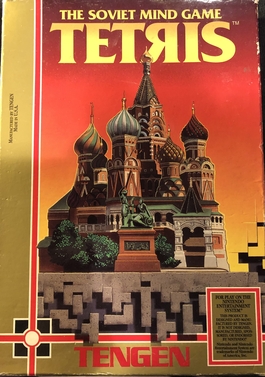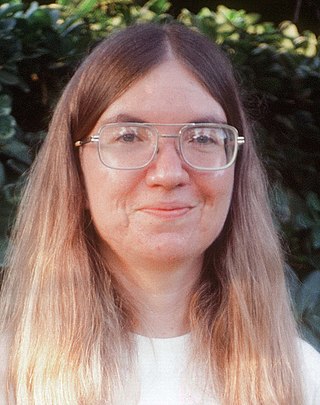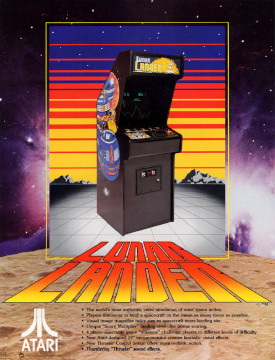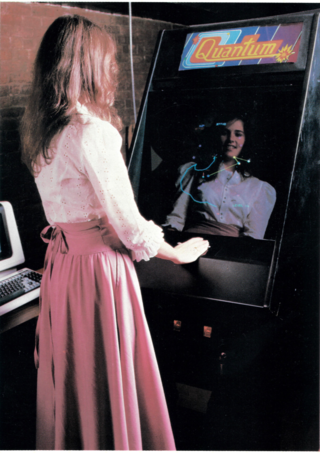
Asteroids is a space-themed multidirectional shooter arcade video game designed by Lyle Rains and Ed Logg released in November 1979 by Atari, Inc. The player controls a single spaceship in an asteroid field which is periodically traversed by flying saucers. The object of the game is to shoot and destroy the asteroids and saucers, while not colliding with either, or being hit by the saucers' counter-fire. The game becomes harder as the number of asteroids increases.

The Atari 2600 is a home video game console developed and produced by Atari, Inc. Released in September 1977 as the Atari Video Computer System, it popularized microprocessor-based hardware and games stored on swappable ROM cartridges, a format first used with the Fairchild Channel F in 1976. The VCS was bundled with two joystick controllers, a conjoined pair of paddle controllers, and a game cartridge—initially Combat and later Pac-Man. Sears sold the system as the Tele-Games Video Arcade. Atari rebranded the VCS as the Atari 2600 in November 1982 alongside the release of the Atari 5200.

The Atari 7800 ProSystem, or simply the Atari 7800, is a home video game console officially released by Atari Corporation in 1986 as the successor to both the Atari 2600 and Atari 5200. It can run almost all Atari 2600 cartridges, making it one of the first consoles with backward compatibility. It shipped with a different model of joystick from the 2600-standard CX40 and Pole Position II as the pack-in game. Most of the announced titles at launch were ports of 1981–1983 arcade video games.

Pac-Man, originally called Puck Man in Japan, is a 1980 maze action video game developed and released by Namco for arcades. In North America, the game was released by Midway Manufacturing as part of its licensing agreement with Namco America. The player controls Pac-Man, who must eat all the dots inside an enclosed maze while avoiding four colored ghosts. Eating large flashing dots called "Power Pellets" causes the ghosts to temporarily turn blue, allowing Pac-Man to eat them for bonus points.

Millipede is a fixed shooter video game released in arcades by Atari, Inc. in 1982. The sequel to 1981's Centipede, it has more gameplay variety and a wider array of insects than the original. The objective is to score as many points as possible by destroying all segments of the millipede as it moves toward the bottom of the screen, as well as eliminating or avoiding other enemies. The game is played with a trackball and a single fire button which can be held down for rapid-fire.

Missile Command is a 1980 shoot 'em up arcade video game developed and published by Atari, Inc. and licensed to Sega for Japanese and European releases. It was designed by Dave Theurer, who also designed Atari's vector graphics game Tempest from the same year. The game was released during the Cold War, and the player uses a trackball to defend six cities from intercontinental ballistic missiles by launching anti-ballistic missiles from three bases.

Danielle Bunten Berry, formerly known as Dan Bunten, was an American game designer and programmer, known for the 1983 game M.U.L.E., one of the first influential multiplayer video games, and 1984's The Seven Cities of Gold.

Centipede is a 1981 fixed shooter arcade video game developed and published by Atari, Inc. Designed by Dona Bailey and Ed Logg, it was one of the most commercially successful games from the golden age of arcade video games and one of the first with a significant female player base. The primary objective is to shoot all the segments of a centipede that winds down the playing field. An arcade sequel, Millipede, followed in 1982.

Ms. Pac-Man is a 1982 maze arcade video game developed by General Computer Corporation and published by Midway. It is the first sequel to Pac-Man (1980) and the first entry in the series to not be made by Namco. Controlling the title character, Pac-Man's wife, the player is tasked with eating all of the pellets in an enclosed maze while avoiding four colored ghosts. Eating the larger "power pellets" lets the player eat the ghosts, who turn blue and flee.

George Edward "Ed" Logg is a retired American arcade video game designer, first employed at Atari, Inc. and later at Atari Games. He currently resides in Los Altos, California. He was educated at University of California, Berkeley and also attended Stanford University.

Tetris is a puzzle game developed by Atari Games and originally released for arcades in 1988. Based on Alexey Pajitnov's Tetris, Atari Games' version features the same gameplay as the computer editions of the game, as players must stack differently shaped falling blocks to form and eliminate horizontal lines from the playing field. The game features several difficulty levels and two-player simultaneous play.

Xybots is a 1987 third-person shooter arcade game by Atari Games. In Xybots, up to two players control "Major Rock Hardy" and "Captain Ace Gunn", who must travel through a 3D maze and fight against a series of robots known as the Xybots whose mission is to destroy all mankind. The game features a split screen display showing the gameplay on the bottom half of the screen and information on player status and the current level on the top half. Designed by Ed Logg, it was originally conceived as a sequel to his previous title, Gauntlet. The game was well received, with reviewers lauding the game's various features, particularly the cooperative multiplayer aspect. Despite this, it was met with limited financial success, which has been attributed to its unique control scheme that involves rotating the joystick to turn the player character.

Centipede is a 3D remake of the 1981 Centipede arcade game from Atari, the original of which was and designed by Ed Logg and Dona Bailey. It was published by Hasbro Interactive in 1998 under the Atari Interactive brand name.

Arcade's Greatest Hits: The Atari Collection 1 is a compilation of Atari arcade games for the Sega Saturn, PlayStation, and Super Nintendo Entertainment System. It is a successor volume to Williams Arcade's Greatest Hits. Most of these games fall into the action game category. The Saturn and PlayStation versions of the game include an FMV documentary on the "Golden Age of Atari", featuring video interviews with the programmers behind the six games in the compilation. The later Super NES version was announced by Midway as their final release for any "16-bit" console.

Carol Shaw is one of the first female game designers and programmers in the video game industry. She is best known for creating the Atari 2600 vertically scrolling shooter River Raid (1982) for Activision. She worked for Atari, Inc. from 1978 to 1980 where she designed multiple games including 3-D Tic-Tac-Toe (1978) and Video Checkers (1980), both for the Atari VCS before it was renamed to the 2600. She left game development in 1984 and retired in 1990.

Dandy is a dungeon crawl maze game for the Atari 8-bit family published by the Atari Program Exchange in 1983. It is one of the first video games with four-player, simultaneous cooperative play. Players equipped with bows and unlimited arrows fight through a maze containing monsters, monster spawners, keys, locked doors, food, and bombs in search of the exit leading to the next level. If a player dies, they can be revived by finding and shooting a heart. The game includes an editor for making new dungeons.

Lunar Lander is a single-player arcade game in the Lunar Lander subgenre. It was developed by Atari, Inc. and released in August 1979. It was the most popular version to date of the "Lunar Lander" concept, surpassing the prior Moonlander (1973) and numerous text-based games, and most later iterations of the concept are based on this Atari version.
Sente Technologies was an arcade game company. Founded as Videa in 1982 by several ex-Atari employees, the company was bought by Nolan Bushnell and made a division of his Pizza Time Theatre company in 1983. In 1984 the division was acquired by Bally Midway who continued to operate it until closing it down in 1988. The name Sente, like Atari, is another reference to Bushnell's favorite game, Go and means "having the initiative."

Elizabeth (Betty) Ryan is an American game developer and programmer. She worked for General Computer Corporation (GCC) in the 1980s and was the 9th employee and first woman video game programmer at GCC. She programmed the 1982 Atari, Inc. arcade game Quantum as well as working on games for the Atari 2600, Atari 5200, and Atari 7800.



















